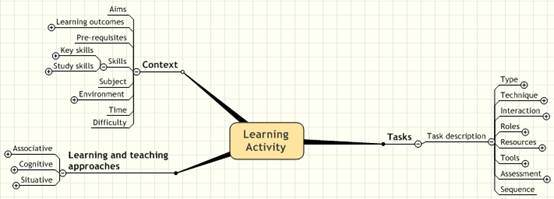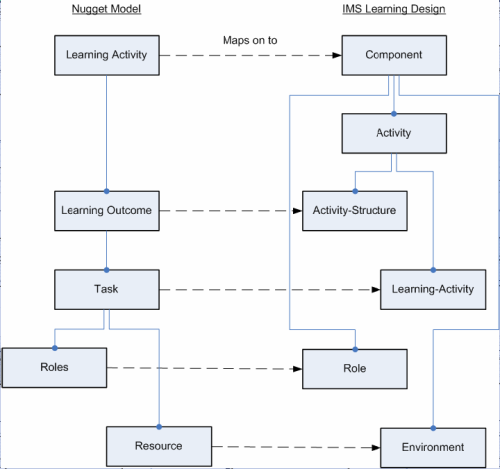DialogPlus Toolkit
Definition
The DialogPLUS Toolkit is to guide and support teachers as they create, modify, and share learning activities and resources.
DialogPLUS is an online browser-based application (free access on 19:19, 22 November 2006 (MET)) and it is sponsored by the British JISC/NSF funded DialogPlus project.
Purpose
This tool is partly inspired by IMS Learning Design and somewhat related toolkits like LAMS and MOT.
According to Conole and Fill (2005: 1), “despite the plethora of Information and Communication Technologies (ICT) tools and resources available, practitioners are still not making effective use of e-learning to enrich the student experience”. The DialogPLUS learning design toolkit should guide practitioners through the process of creating pedagogically informed learning activities which make effective use of appropriate tools and resources.
The learning design toolkit described can be used for three main purposes:
- As step-by-step guidance to help practitioners make theoretically informed decisions about the development of learning activities and choice of appropriate tools and resources to undertake them.
- As a database of existing learning activities and examples of good practice which can then be adapted and reused for different purposes.
- As a mechanism for abstracting good practice and metamodels for e-learning
The tool
We firstly will describe a few concepts used in the modelling framework and then shortly describe the system.
Concepts
At the heart of this instructional design method are nuggets, i.e. learning activities or pedagogical scenarios. Nuggets embody both learning activities and resources. Nuggets are activity-based learning objects. “Nuggets range in size (from a single file, to a mini-website), formats (word documents, powerpoint slides, html, flash etc), media (text, images, animations) and educational styles (learning material, assessments, activities, resources).” ([1]), retrieved 11:37, 23 November 2006 (MET)).
The software uses a nugget taxonomy as a language to to specify the nugget and its components. Below we reproduce some concept maps produced by the authors that illustrate a few selections a teacher/designer has to make when he designs a "nugget". These concept maps probably do not reflect the current state of the system, but they give an idea of the kind of design decisions that are being modeled. Also, please note that we don't show all expanded "nodes" of the model.
The learning activity
The notion of a learning activity (LA) is at the heart of the "nugget" and the tool and it is composed of three elements:
- The context of the activity: e.g. subject, level of difficulty, intended learning outcomes and the environment within which the activity takes place.
- The learning and teaching approaches: including theories and models.
- The learning tasks: This includes type of task, techniques used, associated tools and resources, interaction and roles of those involved and learner assessment.
Learning and teaching approaches
The tool supports a variety of instructional design models. DSchneider thinks that it definitely fits a modern activity-based instructional design perspective, e.g. as an alternative to more traditional lesson planners and more in the spirit of more powerful tools like MOT+, but being much easier to learn.
With the tool, the teacher can explicitly state a given pedagogical approach, but the design itself is then defined through tasks.
Tasks
A task is firstly defined by a description, a length, a type, a technique and interaction. A task then assigns roles and includes resources, tools and assessment.

- Task types
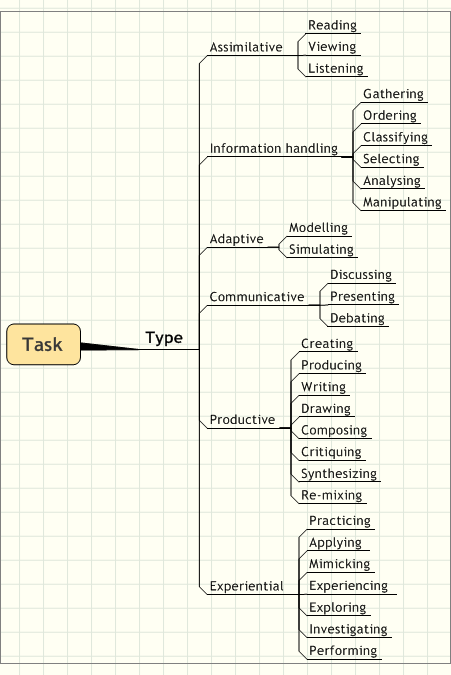
- Task techniques
Task techniques include brainstorming, exercise, field work, role play, reflection and syndicates. The authors “identified almost thirty techniques to be stored in the toolkit such that advice can be offered to practitioners. Interactions required are likely to be individual, one to many, student to student, student to tutor, group or class base”.
- Task resources
Available resources and tools are based on the Laurillard conversational framework five principal media forms (Narrative, Communicative, Adaptive, Productive, and Interactive) (Laurillard, 2002, p.90).
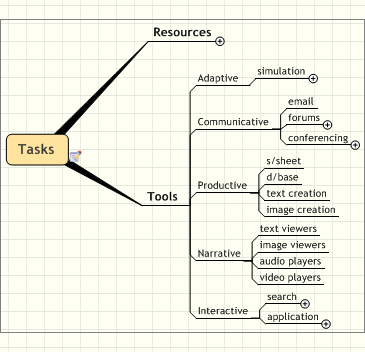
- Assessment types
Not surprisingly, there is a large palette of assessment types and techniques.
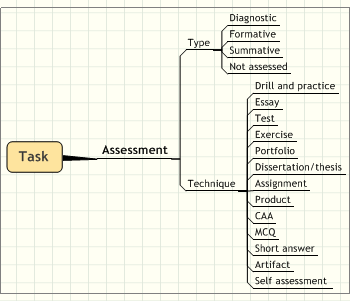
The tool
The tool is available as on-line Web application. External users may create an account (checked on 20:24, 22 November 2006 (MET)).
(needs some description here - DSchneider)
DialogPlus can export to IMS Learning Design
DialogPlus is also integrated with ConceptVISTA, a ontology creation and visualization tool that stores ontologies in the Web Ontology Language (OWL)
Current status
As of Nov 2006, the DialogPlus toolkit is being further evaluated, together with LAMS, as tools for teacher development as learning activity designers in the JISC funded EDIT4L project, part of the Design for Learning programme.
DialogPlus vs. IMS Learning Design =
Bailey et al. (2006). Panning for Gold explains that there are many structurals similarities between DialogPlus and IMS Learning Design and this is why DialogPlus can export to IMS LD.
Here is a figure (reproduced without permission for the moment) from this paper that summarizes the situation:
Discussion
Comments by DSchneider
I will try this out sometimes over the next 2-3 weeks and start by writing down my impressions (18:33, 23 November 2006 (MET)). Please understand that these are just notes and that these may sound negative, since pointing out problems is an easy thing to do. Some things may have to be corrected later ...
- General
- Given the complex scenario descriptions the tool can handle, it's fairly easy to understand how to use it (globally speaking). Overally speaking, I have a good impression and this tool certainly could be used in teacher education.
- The nugget definition
- Nugget aims can not be re-edited
- The generic nugget module window provides a useful overview, but it doesn't make sense to use a separate column to display various nugget categories. Even with my 3500 px two 20 + 24 screens...
- Task definitions
- The task can't be described. Not sure that it is enough to describe with various taxonomy elements.
- It is not practical to have to enter the same resource or tool several times. One ought to be able to link various tasks to one single resource or tool. E.g. a same wiki can be use to look up definitions, to find further readings, to compose a project page, to add/modify definitions, to discuss. A similar remark concerns function. One tool can have more than one function. Of course media have affordances, but a tool is instrument because of way it is being used.
- Resources and tools can not be edited.
- IMS LD export
- Export to IMS LD works, but the result can't be loaded into the Reload LD Player (there is a missing identifier attribute in the manifest, learnobjectid is defined twice, ...). I will try to fix the manifest by hand later.
- ConceptVISTA
- I didn't understand really how the 2 are integrated (but didn't really try so far)
Links
- DialogPLUS On-line Application
- Project websites and related
- DialogPlus Home Page (Note: The old http://www.dialogplus.org/ website is no longer supported)
- EDIT4L, Evaluation of Design and Implementation Tools for Learning
- JISC Design for learning. A larger British project (2006 - 2088) for projects in developing, implementing and evaluating tools and systems that support design for learning.
- Other
- Fill, K., Bailey, C., Conole, G. & Davis, H. (2004). "Supporting teachers: the development and evaluation of a learning design toolkit." ALT-C 2004, Exeter, UK. Abstract (and PPT)
References
- Bailey, C., Zalfan, M. T, Davis, H. C., Fill, K., & Conole, G. (2006). Panning for Gold: Designing Pedagogically inspired Learning Nuggets. Educational Technology & Society, 9 (1), 113-122. PDF Reprint.
- Gráinne Conole and Karen Fill (2005). A learning design toolkit to create pedagogically effective learning activities. Journal of Interactive Media in Education (Advances in Learning Design. Special Issue, eds. Colin Tattersall, Rob Koper), 2005/08. ISSN:1365-893X Abstract (PDF/HTML open access)
- Conole, G. & Fill, K. "Designing a Learning Activity Toolkit." Ed-Media 2004 Poster, Lugano, Switzerland PPT
- Laurillard, D. (2002). Rethinking University Teaching. A conversational framework for the effective use of learning technologies. London: Routledge ISBN 0415256798 .
- Other publications to sort out ...
- Conole, G. (2002). 'Systematising Learning and Research Information', Journal of Interactive Media in Education, 7. Abstract (HTML/PDF).
- Conole, G. (2004). 'Report on the effectiveness of tools for e-learning', report for the JISC commissioned Research Study on the Effectiveness of Resources, Tools and Support Services used by Practitioners in Designing and Delivering E-Learning Activities. [cited] [cited]
- Conole, G. and Dyke, M. (2004). 'What are the affordances of Information and Communication Technologies', ALT-J, 12.2,113-124.
- Conole, G., Dyke, M., Oliver, M. and Seale, J. (2004). 'Mapping pedagogy and tools for effective learning design', Computers and Education, 43 (1-2), 17-33
- Conole, G. and Oliver, M. (2002). 'Embedding Theory into Learning Technology Practice with Toolkits, Journal of Interactive Media in Education, Special issue on learning technology theory', Open University, 2002(8), http://jime.open.ac.uk/.
